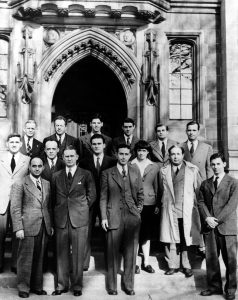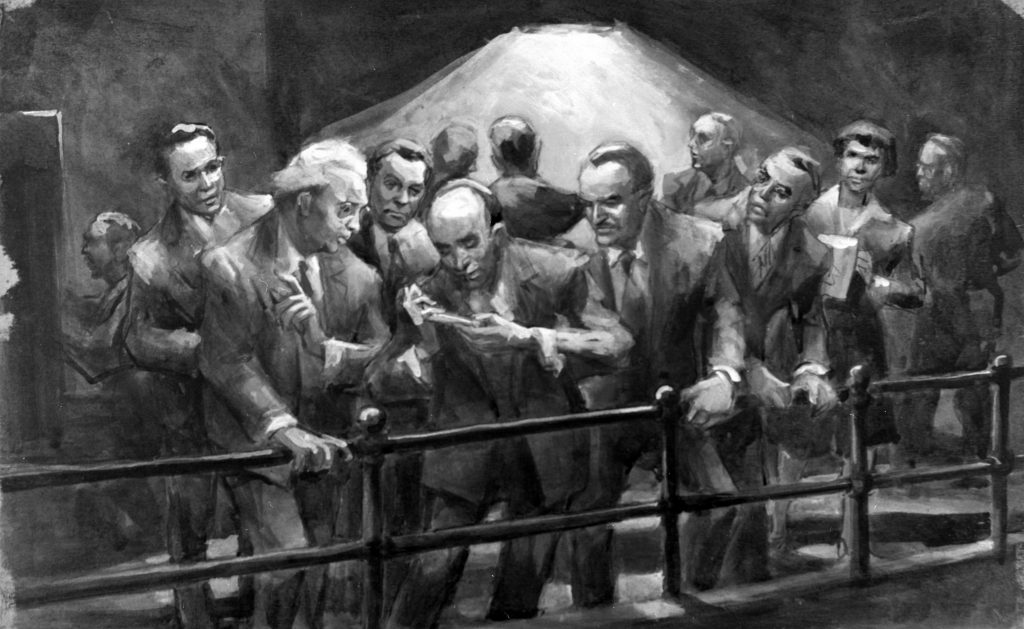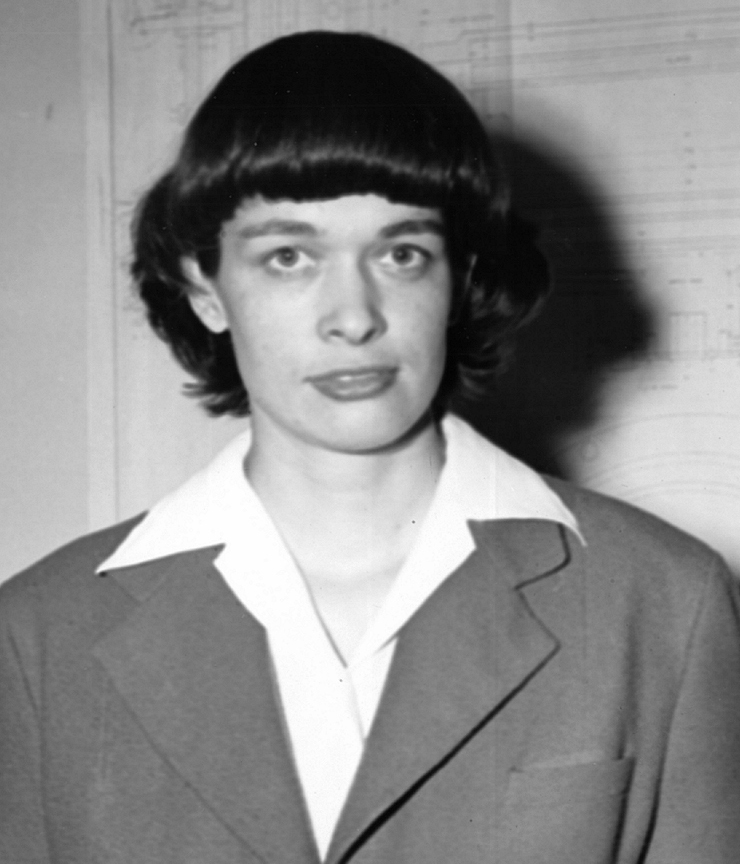“When do we become scared?” asked Leona Marshall Libby as Chicago Pile-1 went critical on December 2, 1942. Libby, arguably the most influential female scientist to work on the Manhattan Project, was then only 24 years old. As her son would later remember, “She said there were people who tried to discourage her and she just sort of outworked and outshone some of the best of them. The project was so secret they had to figure out something to do with a clever woman.” As well as working at the Chicago Met Lab, Libby would go on to work on reactor development at Hanford, Washington.
Building the Pile

Libby graduated from the University of Chicago with a B.S. in chemistry, and while working on her Ph.D. she was hired at the Chicago Met Lab in 1942.
She later recalled, “My job was to use the expertise I already had to build boron trifluoride counters for detection of the neutron flux in the chain-reacting pile yet to be built. But [Enrico] Fermi gave me also the job of taking notes on his lectures to the crew who would build the chain-reacting pile under the west stands” (Libby 118). Libby also remembered the fervor which overtook the scientists at the Met Lab:
I think everyone was terrified that we were wrong [in our way of developing the bomb] and the Germans were ahead of us. That was a persistent and ever-present fear, fed, of course, by the fact that our leaders knew those people in Germany. They went to school with them. Our leaders were terrified, and that terror fed to us. If the Germans had got it before we did, I don’t know what would have happened to the world. Something different. Germany led in the field of physics, in every respect, at the time war set in, when Hitler lowered the boom. It was a very frightening time.
Although she was not allowed to handle the graphite blocks used to build Chicago Pile-1, Libby helped calibrate the equipment used to measure CP-1’s out
put. She remembered that as the pile went critical, “I read the counts of the standard boron trifluoride counter in a loud voice: ‘Two, two, three, one, etc.’ these being the counts in 10-second intervals with the control rod still inside the pile” (Libby 121).
Libby was the only woman present when Chicago Pile-1 went critical. She remembered that “somewhat later, after the control rods were all put to bed and the charts were pulled out and clipped up and so on, Eugene Wigner showed up with a famous little flask of Chianti. He poured it into a paper cup. He went and drank it very quietly. There was no toast, nothing, no remarks. Nothing very dramatic, really: The most effective kind of drama probably at that point.”

During her time at Chicago, Libby also developed a close relationship with Enrico Fermi, who she described as “a marvelously wise director of scientific effort in the sense that he knew exactly where to be careful, and he could very frequently guess when it was unnecessary to make more accurate measurements. He had a very good sense of the degree of effort that would give the required result without wasting it.” The two would remain close for the years to come after the war.
Soon after the pile was moved to Argonne, Fermi would keep Libby’s confidence in concealing a secret that almost prevented her from continuing her work at Chicago: she was pregnant. Libby had married fellow Met Lab scientist John Marshall in July 1943 and became pregnant soon after. For the next few months, Libby wore baggy clothes to work to conceal her pregnancy. As she later remembered, “Close to the end of the canonical 9 months, Enrico began to worry about the 27 miles that separated the Argonne and Lying-In Hospital at the University of Chicago. He was worried that labor might come on suddenly, and so he asked for instructions from Laura [Fermi] on how to deliver a baby if need be on top of CP-2…” This would not come to pass, because as Libby explained, she “went to the hospital a couple of days early with high blood pressure, and came out with a baby and was back at work in a week, not quite on par with Italian peasants, but close to it” (Libby 164).
“Babysitting” Plutonium
In 1944, Libby and Marshall moved to Hanford to work on the plutonium production B Reactor. The officer-in-charge at Hanford, Colonel Franklin Matthias, would remember Libby as “a great gal.” During an incident on September 27, 1944, the reactor lost all power only hours after going critical. Libby recalled that “people stood around and stared at each other.” Libby was among the group that would discover that the reactor was suffering from xenon-135 “poisoning,” which absorbed neutrons faster than they were produced, thus shutting down the reactor. According to Libby, they were the “babysitters” of the Hanford reactor.
Dropping the Bomb
Although Libby was not involved in the decision to drop the bomb, she later defended it:
I certainly do recall how I felt when the atomic bombs were used. My brother-in-law was captain of the first minesweeper scheduled into Sasebo Harbor. My brother was a Marine, with a flame thrower, on Okinawa. I’m sure these people would not have lasted in an invasion. It was pretty clear the war would continue, with half a million of our fighting men dead not to say how many Japanese. You know and I know that General (Curtis) LeMay firebombed Tokyo and nobody even mentions the slaughter that happened then. They think Nagasaki and Hiroshima were something compared to the firebombing. THEY’RE WRONG! I have no regrets. I think we did right, and we couldn’t have done it differently. Yeah, I know it has been suggested the second bomb, Nagasaki, was not necessary. The guys who cry on shoulders. When you are in a war, to the death, I don’t think you stand around and ask, “Is it right?”
On the subject of worldwide proliferation, Libby also affirmed, “You can’t stop it. How can you stop it? You’re going to tell a guy like [Muammar] Gaddafi, ‘Don’t buy that bomb from the Israelis,’ or wherever you’re going to buy it? You can tell him, and he’s going to do—I mean you cannot stop the wheels. That’s my view. And again, the do-gooders and the crying on shoulders, these guys have got blue-eyed optimism that is not useful.”
Post-War Activities
After the war, Libby researched at Princeton University alongside J. Robert Oppenheimer, before going to work for the RAND Corporation, a think tank which would play an important role in developing United States’ nuclear strategy during the Cold War. Among Libby’s many papers for RAND was research on the environmental impact of human activity and world pollution. She would later go to teach at UCLA, where she helped to create the department of environmental science and engineering.
Libby died on November 10, 1986, in Santa Monica, California. In 2016, the Leona Libby Middle School was established in Richland, Washington.
More Historical Resources:
Libby, Leona Marshall. The Uranium People. New York, NY: Crane Russak, 1979.





